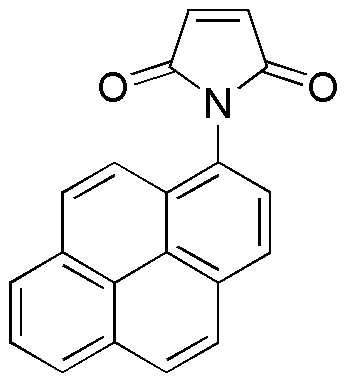N-(1-Pyrenyl)maleimide is widely utilized in research focused on:
- Fluorescent Probes: This compound serves as a fluorescent label in biological research, allowing scientists to track cellular processes and interactions with high sensitivity.
- Polymer Chemistry: It is used in the synthesis of functionalized polymers, enhancing their properties for applications in coatings and materials science.
- Bioconjugation: The compound is effective in attaching biomolecules to surfaces, which is crucial for developing biosensors and diagnostic tools.
- Photophysics Studies: Researchers utilize it to study energy transfer and photophysical properties, contributing to advancements in photonic devices.
- Drug Delivery Systems: Its unique properties enable the design of targeted drug delivery systems, improving therapeutic efficacy and reducing side effects.
General Information
Properties
Safety and Regulations
Applications
N-(1-Pyrenyl)maleimide is widely utilized in research focused on:
- Fluorescent Probes: This compound serves as a fluorescent label in biological research, allowing scientists to track cellular processes and interactions with high sensitivity.
- Polymer Chemistry: It is used in the synthesis of functionalized polymers, enhancing their properties for applications in coatings and materials science.
- Bioconjugation: The compound is effective in attaching biomolecules to surfaces, which is crucial for developing biosensors and diagnostic tools.
- Photophysics Studies: Researchers utilize it to study energy transfer and photophysical properties, contributing to advancements in photonic devices.
- Drug Delivery Systems: Its unique properties enable the design of targeted drug delivery systems, improving therapeutic efficacy and reducing side effects.
Documents
Safety Data Sheets (SDS)
The SDS provides comprehensive safety information on handling, storage, and disposal of the product.
Product Specification (PS)
The PS provides a comprehensive breakdown of the product’s properties, including chemical composition, physical state, purity, and storage requirements. It also details acceptable quality ranges and the product's intended applications.
Certificates of Analysis (COA)
Search for Certificates of Analysis (COA) by entering the products Lot Number. Lot and Batch Numbers can be found on a product’s label following the words ‘Lot’ or ‘Batch’.
*Catalog Number
*Lot Number
Certificates Of Origin (COO)
This COO confirms the country where the product was manufactured, and also details the materials and components used in it and whether it is derived from natural, synthetic, or other specific sources. This certificate may be required for customs, trade, and regulatory compliance.
*Catalog Number
*Lot Number
Safety Data Sheets (SDS)
The SDS provides comprehensive safety information on handling, storage, and disposal of the product.
DownloadProduct Specification (PS)
The PS provides a comprehensive breakdown of the product’s properties, including chemical composition, physical state, purity, and storage requirements. It also details acceptable quality ranges and the product's intended applications.
DownloadCertificates of Analysis (COA)
Search for Certificates of Analysis (COA) by entering the products Lot Number. Lot and Batch Numbers can be found on a product’s label following the words ‘Lot’ or ‘Batch’.
*Catalog Number
*Lot Number
Certificates Of Origin (COO)
This COO confirms the country where the product was manufactured, and also details the materials and components used in it and whether it is derived from natural, synthetic, or other specific sources. This certificate may be required for customs, trade, and regulatory compliance.


